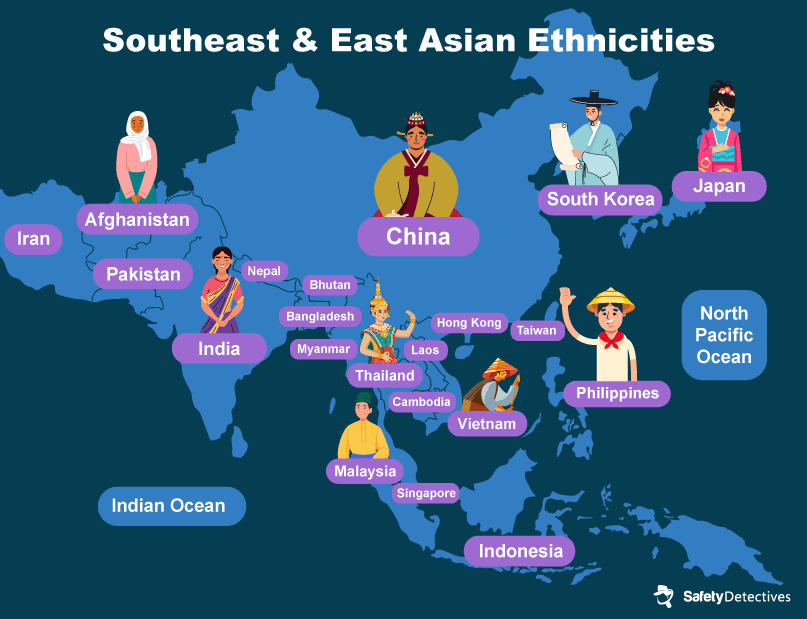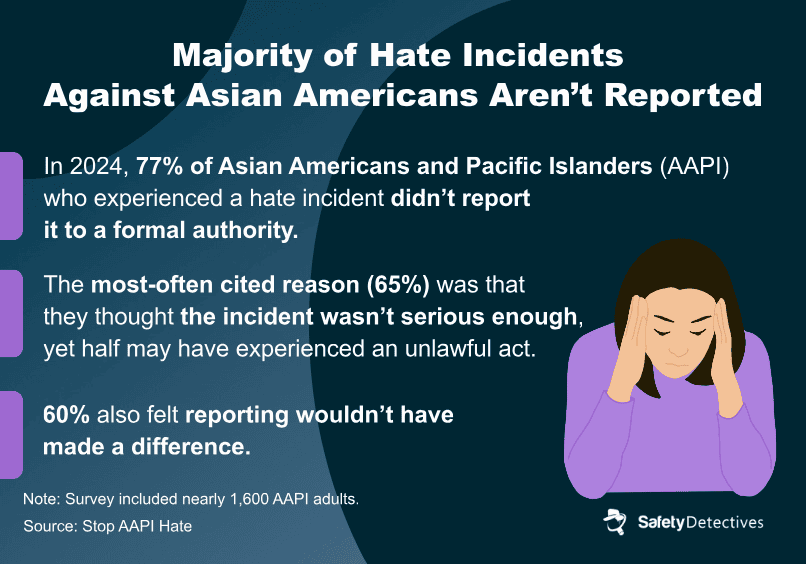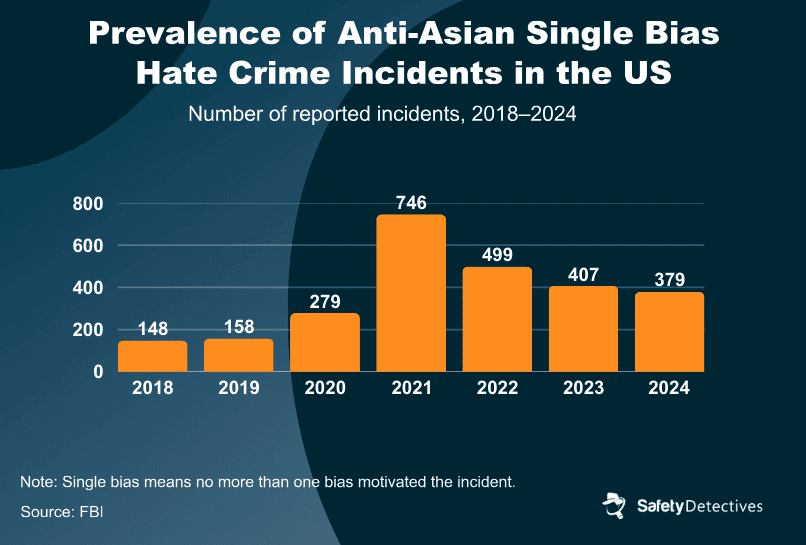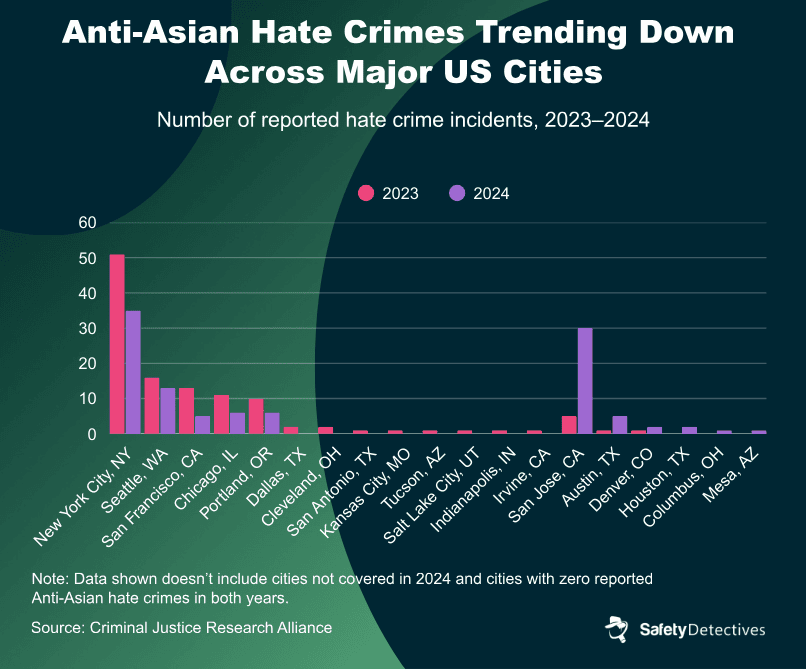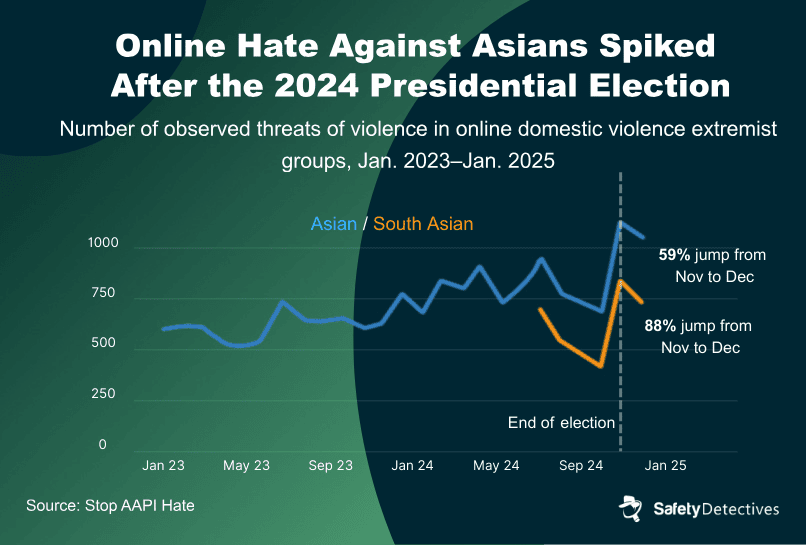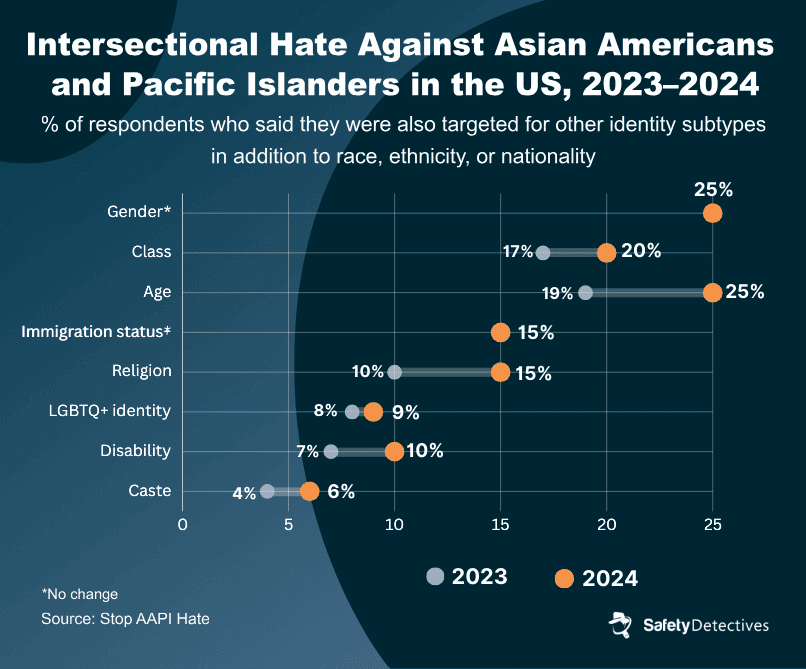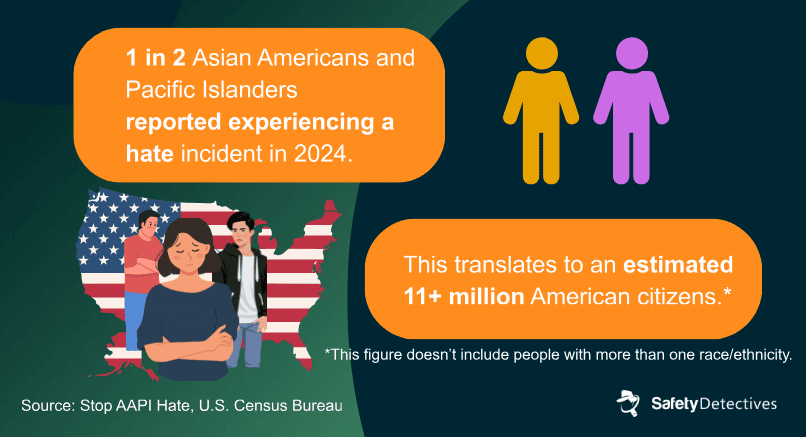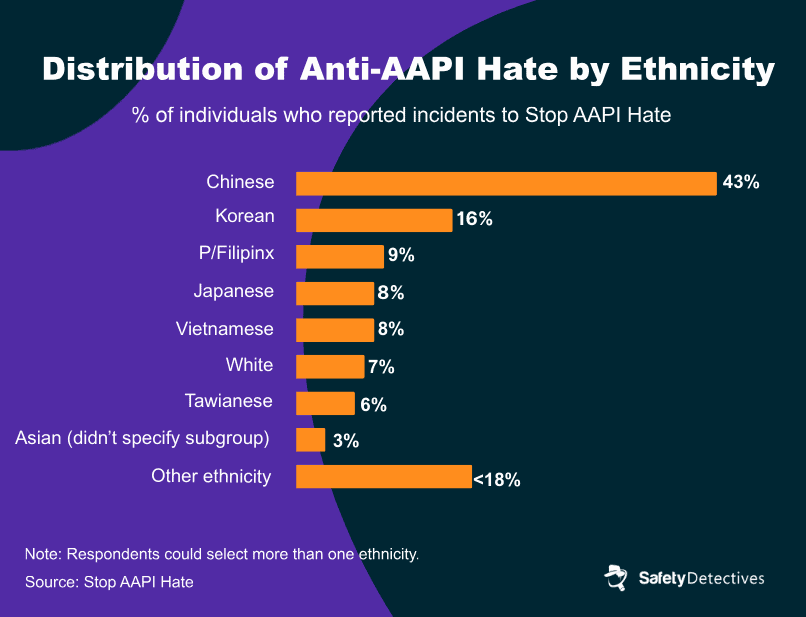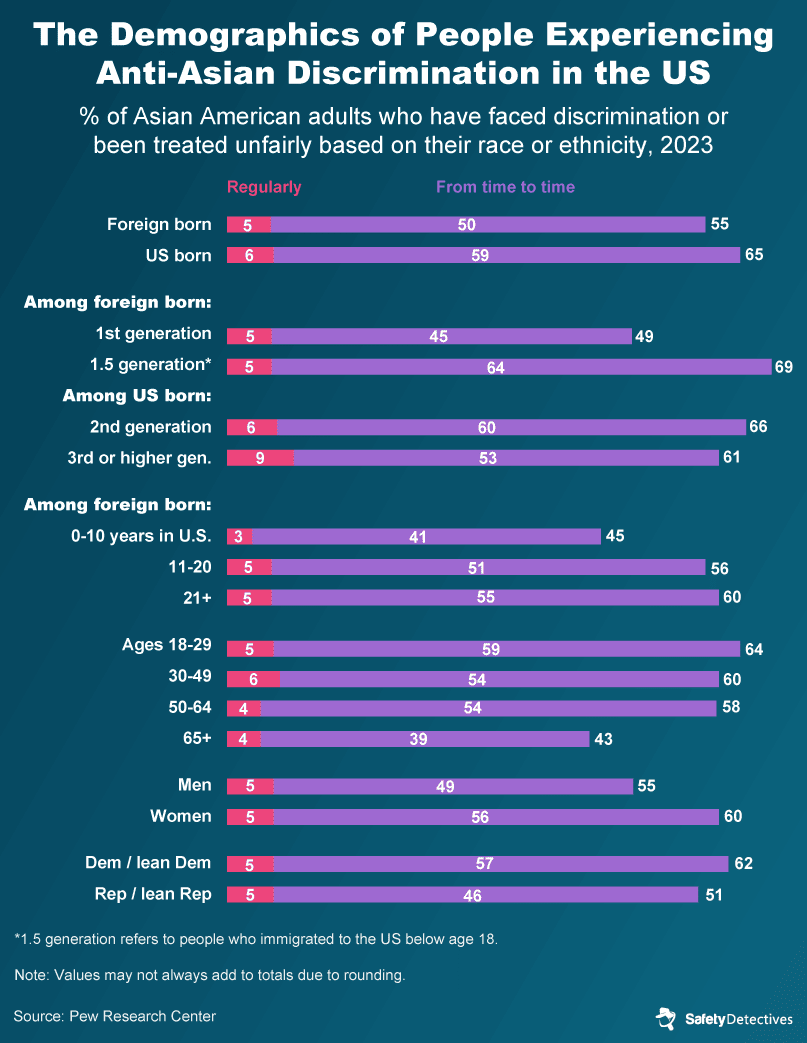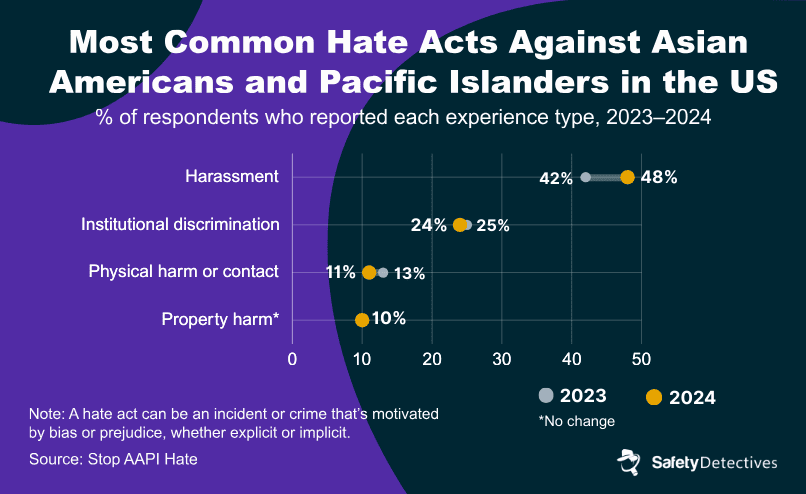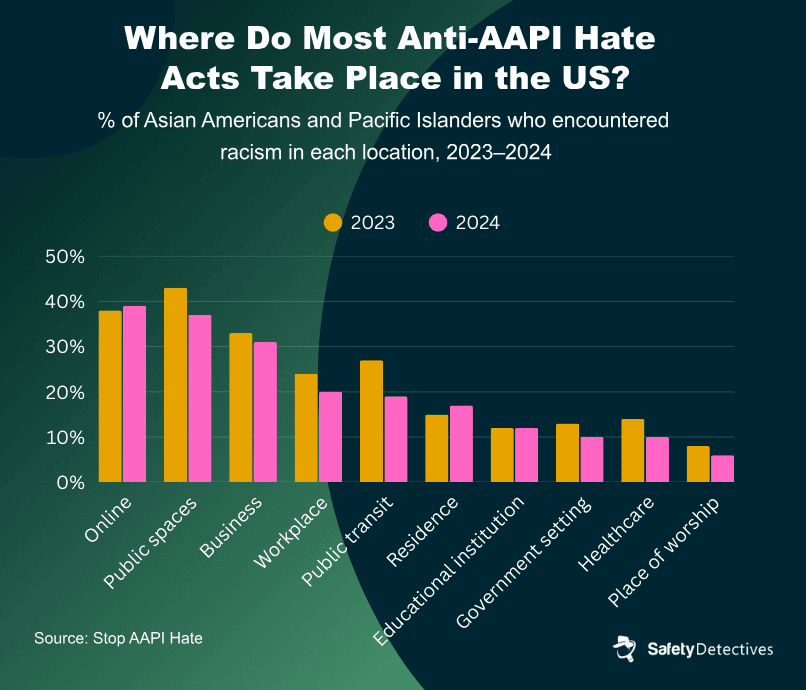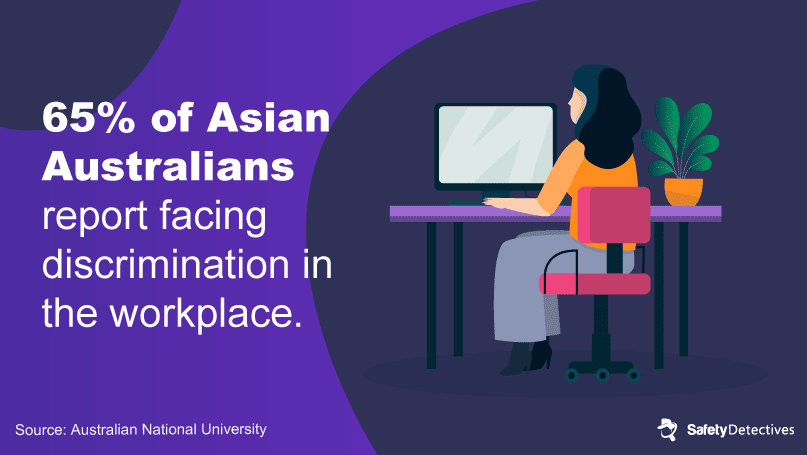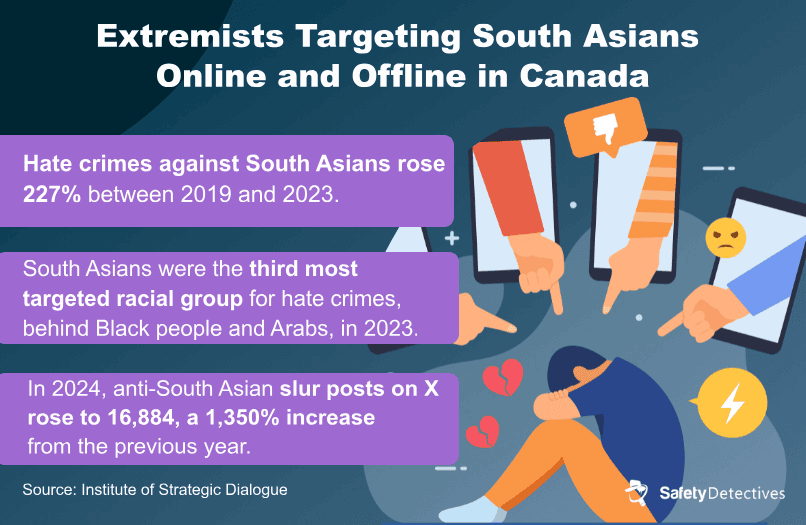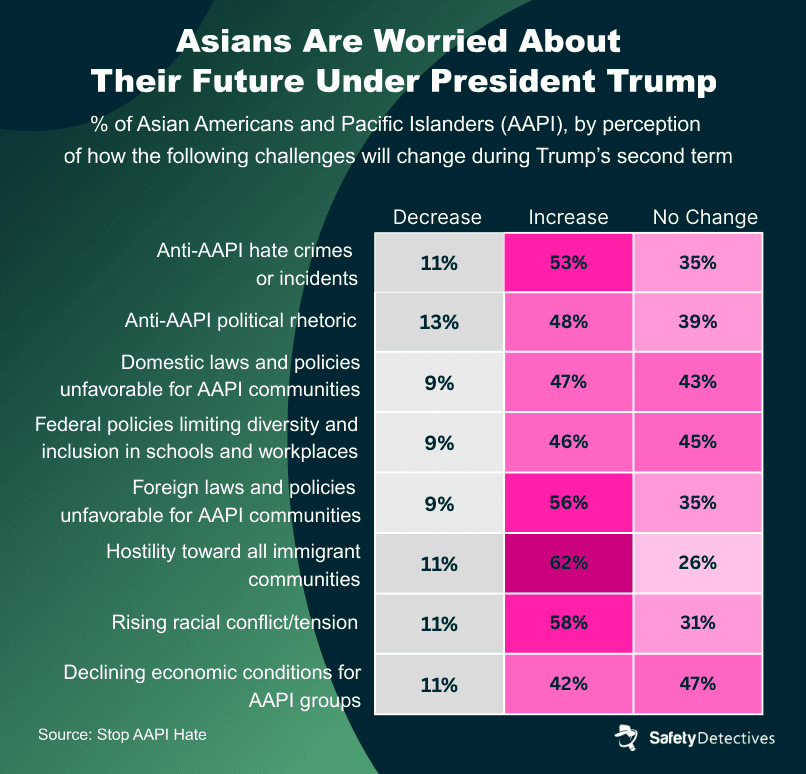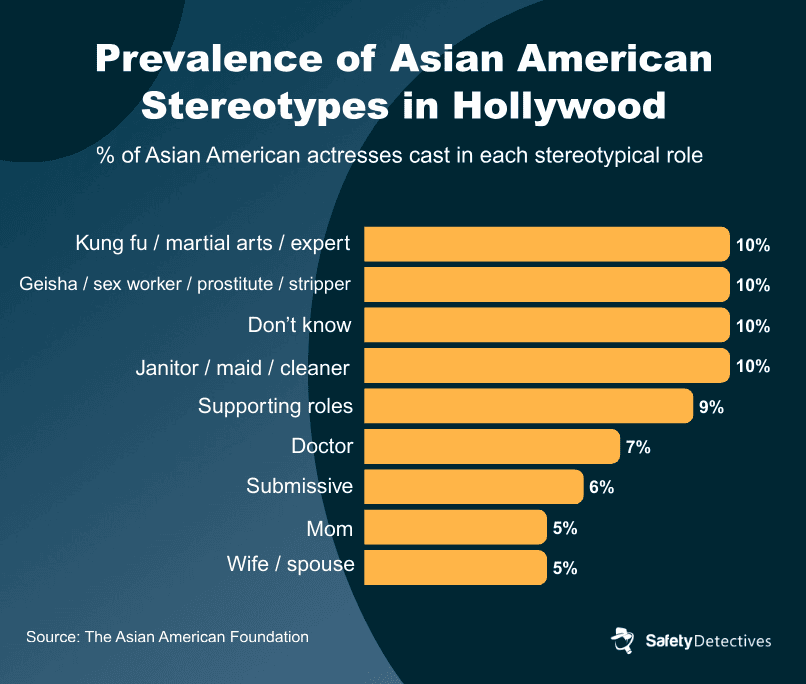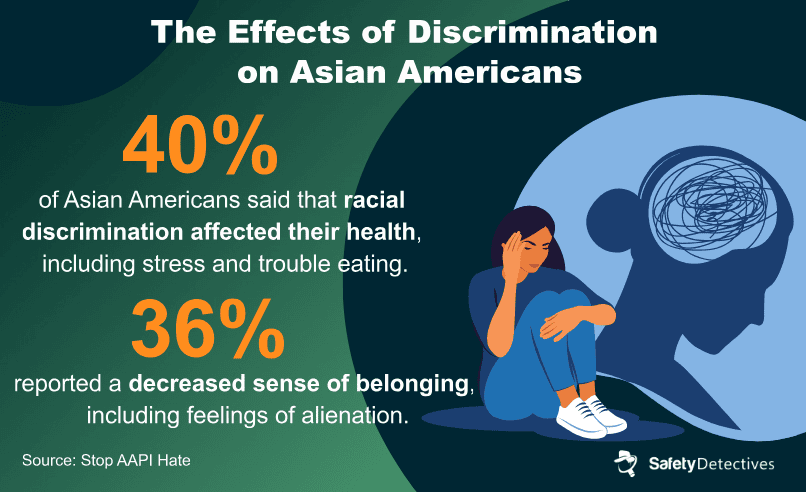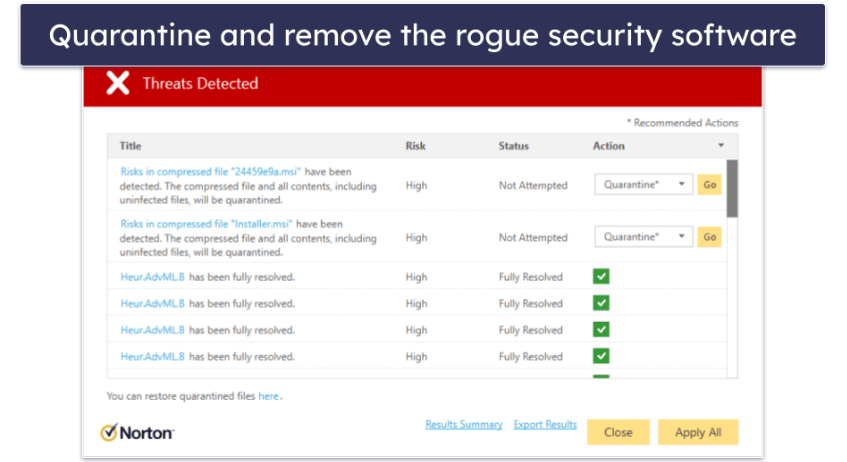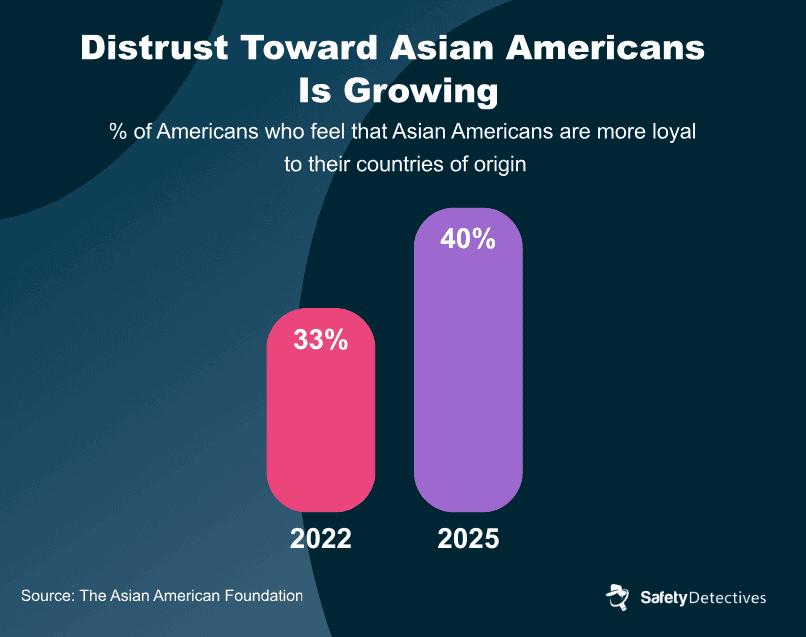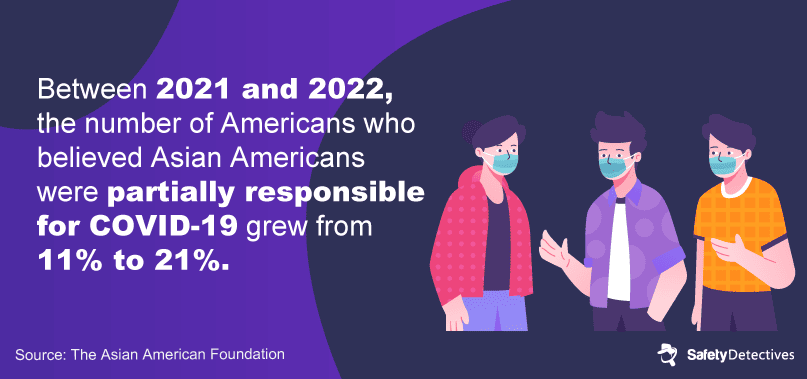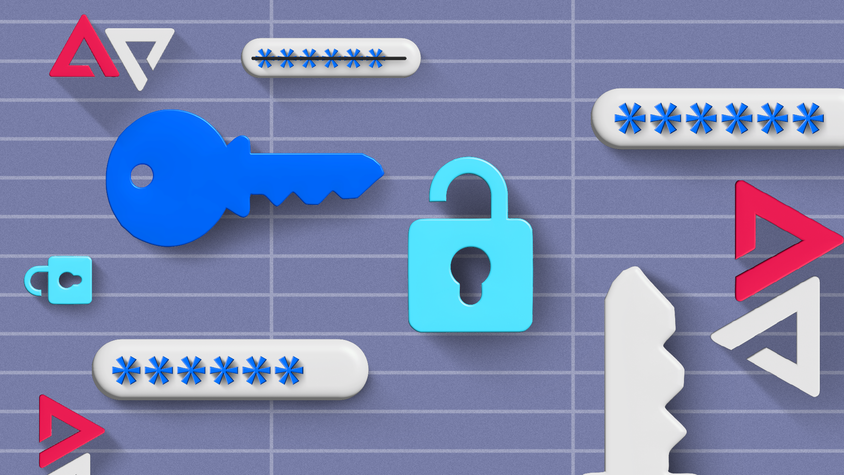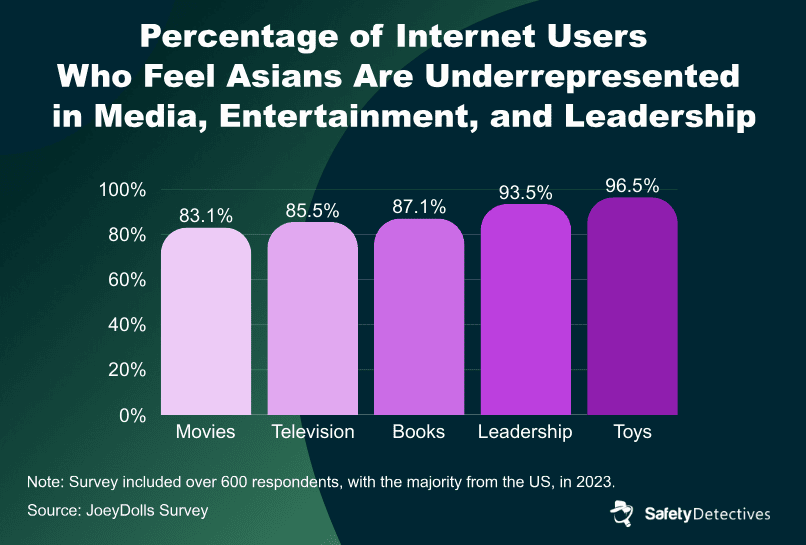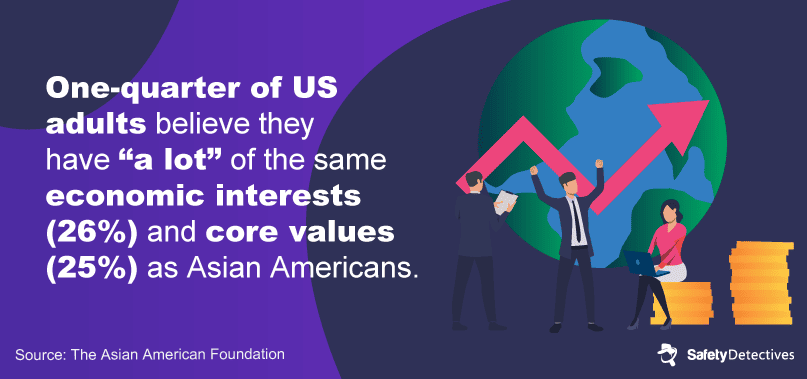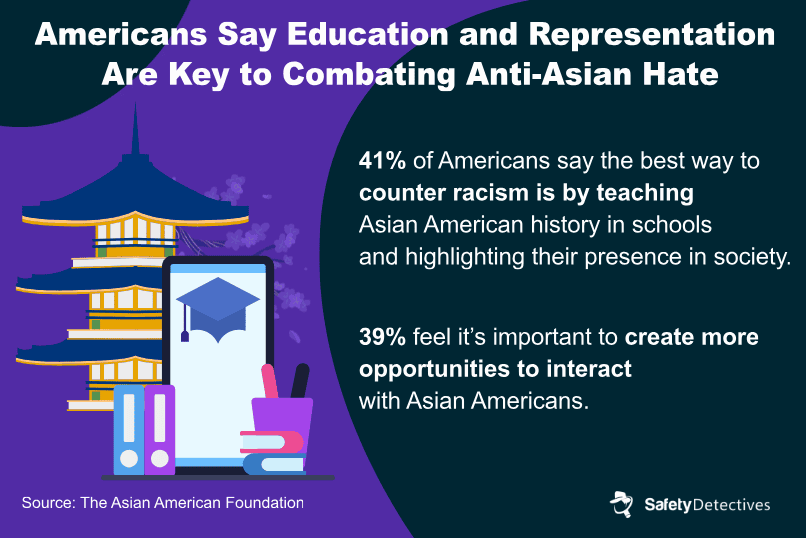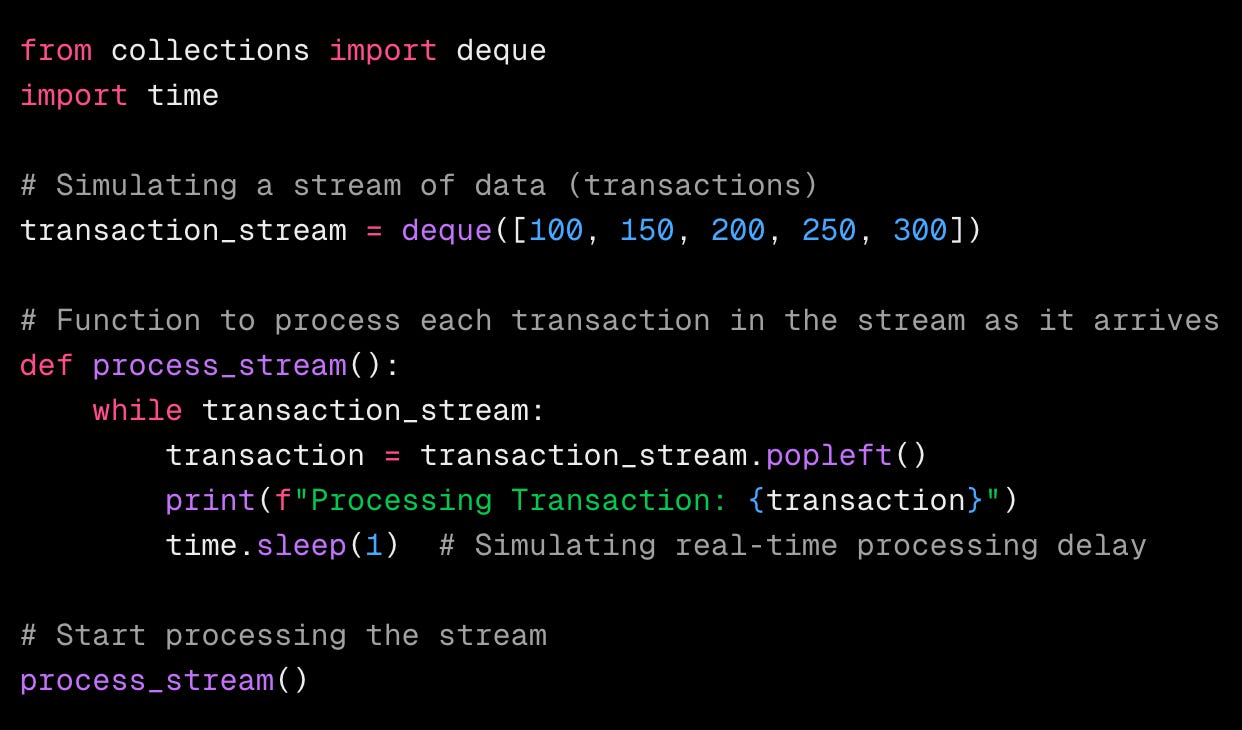Monica J White
Updated on: September 5, 2025
Following the re-election of President Trump, reports surged of growing anti-Asian sentiment online. Moreover, Asian Americans are seeing a broader pattern of discrimination and prejudice in the country. However, reading and sharing resources such as this one can help to improve the situation.
Educating yourself and others about the scale and impact of anti-Asian prejudice is the best way to better understand those who experience racism. Sharing information about their experiences helps to uplift their voices, foster compassion, and diminish prejudice or ignorance to the problem.
To help, I’ve compiled 25 facts and statistics about anti-Asian hate. I’ll cover the history of anti-Asian hate; look at key trends in where, how, and toward whom it’s perpetrated; and share stats about its causes and impacts.
To finish, I’ll explore some of the things we can do as a society to fight back against anti-Asian discrimination.
An Overview of Anti-Asian Hate
Anti-Asian hate refers to any racially-motivated prejudice, discrimination, or hostility that targets Asian people. People of Asian ethnicity or heritage, as well as Pacific Islanders, are subjected to this form of racism.
The following forms of persecution and mistreatment of people of Asian ethnicity can all be examples of anti-Asian hate:
- Discrimination
- Physical assault
- Verbal assault/hate speech
- Violent crimes
- Harassment
- Microaggressions
Anti-Asian hate is most commonly perceived in relation to Asian immigrants’ experience of racism within the West. In the US, anti-Asian hate typically refers to discrimination targeting Chinese, East, and Southeast Asians. In the UK, it also commonly manifests as racism targeting people of South Asian descent.
In many instances, the discrimination felt by Asian people in the West is driven by institutionalized racism. This is because the way in which political, economic, and legal systems have been designed tends to exclude people of Asian or other non-European heritage.
Anti-Asian hate also includes discrimination between people of different Asian ethnicities. Anti-Asian rhetoric within the region is often linked to past geopolitical conflicts and territorial disputes.
For example, in Vietnam, distrust of Chinese people is fueled by centuries of conflicts, including the nations’ relatively recent 1979 border war. The same is true for the Japanese and South Koreans, 90% of whom consider China’s rising military influence as a “bad thing”.
The Difficulties with Anti-Asian Hate Statistics
While there’s plenty of data about anti-Asian hate, it can be difficult to translate this into meaningful statistics. There are a variety of reasons for this.
Underreporting
Much of the data about anti-Asian discrimination and hate crimes is self-reported. Some victims may not report incidents at all, while others may institute false reports or embellish their experience. For example, women are far more likely to report incidents than men, often making it look like one group is subject to more discrimination than another.
Underreporting is particularly common among Asian immigrant communities. Cultural beliefs, such as the idea that they might suffer humiliation or disgrace their families, can be barriers to seeking assistance. Others may unknowingly internalize and accept the racism they experience simply as a part of life.
Fear of repercussions, distrust of law enforcement, and language barriers in filing reports are other common reasons why Asians don’t report their experiences of hate.
Another layer is added when law enforcement agencies come into the picture. There are several reasons why these agencies may not pass all of the reports that they’ve gathered on to the statistical bureaus that aggregate them and publish the data.
Whatever the explanations might be for this lapse in reporting, the effect is that not all anti-Asian hate incidents necessarily form part of hate crime and discrimination data.
Poor Survey Design
The quality of statistics are directly related to the quality of the survey that was used to gather them. Ambiguous, leading, and confusing questions often appear in surveys and can all drive skewed results.
Sample Sizes
Small sample sizes, which can be particularly common when gathering information on the experiences of minority groups, can result in misleading findings. A small sample size will not only skew the appearance of statistics, but can also affect how representative the sentiment is within the broader community.
The History of Anti-Asian Discrimination
Understanding the past is key to figuring out where anti-Asian discrimination stems from. By examining patterns of intolerance that have taken root over centuries, we can better identify effective actions for dismantling the structures and mindsets that perpetuate these behaviors.
1. Timeline of Anti-Asian Hate Incidents Worldwide
Throughout history, people of Asian descent have faced discrimination, violence, and exclusionary laws across the globe.
In the 19th century, the legal system in the United States set a precedent with cases like People v Hall, where Asian witness testimonies were deemed invalid. This era also saw brutal attacks such as the Chinese Massacre in Los Angeles and the Rock Springs Massacre, where Chinese immigrants were targeted and killed.
The Chinese Exclusion Act of 1882 effectively banned Chinese immigration to the US for 10 years. It legitimized the discrimination of Chinese migrants and marked a significant turning point in their treatment by law. As the 20th century kicked off, other countries followed suit, instituting their own anti-Asian laws. Australia’s Immigration Restriction Act, which required those entering the country to write a passage in a European language, effectively excluded Chinese immigrants, while Canada’s Chinese Immigration Act imposed hefty entry fees on these immigrants.
Asians have also been subjected to violence by their fellow citizens. From race riots in Lima, Peru, and the Torreón Massacre in Mexico, to the Kantō Massacre in Japan and the forced relocation of Koreans in the Soviet Union, people of Asian ethnicity have often been treated cruelly.
The internment of Japanese Americans during World War II stands as a particularly dark chapter in American history, with over 100,000 individuals unjustly detained. Post-war, discrimination persisted with events like the Chinese Massacre of 1969 in Malaysia and the murder of Vincent Chin in the United States in 1982.
In the 21st century, hate crimes surged following events like the 9/11 attacks and the COVID-19 pandemic. Incidents like the Atlanta shootings and legislative actions, such as the Texas Senate Bill 147 that prevents certain Asian citizens from purchasing farmland, highlight the ongoing struggles faced by Asian communities.
2. Number of Anti-Asian Incidents Is Still High After the Pandemic
While the number of hate incidents against Asian Americans in 2024 has decreased from a peak in 2021, it’s still 2.4 times the number of reported cases in 2019, prior to the pandemic.
3. Anti-Asian Hate Crimes Fell Across US Cities in Line with Overall Trends
Based on estimates, when compared to 2023, the total number of reported hate crime cases in 2024 decreased by 2.7%, to 3268 cases.
Cases dropped significantly in New York (-31%), Chicago (-45%), and San Francisco (-62%). Conversely, San Jose saw a six-fold increase from 5 to 30 cases, while Austin registered a five-fold increase from 1 to 5 cases.
Overall, anti-Asian hate crimes fell by 19% to 116 cases, making up only 3.5% of hate crimes. This is a stark contrast from the trend at the onset of the pandemic, when anti-Asian hate crimes rose by 1.5 times across the cities studied in 2020.
4. Anti-Asian Sentiment Surged Online Following President Trump’s Election Win
President Trump’s win in the 2024 election fueled a sharp rise in online hate against Asians. From November to December 2024, violent threats surged 59% against Asians, and 88% against South Asians, in extremist subgroups in online spaces like 4Chan and Reddit.
The number of anti-Asian slurs peaked in January 2025, the highest since Stop AAPI Hate started monitoring in August 2022. The most targeted victims were South Asians, making up 73% of racist slurs and 75% of violent threats between December 2024 and January 2025.
Anti-immigrant sentiment is one of the key drivers of the hostility toward Asians, ignited by Trump’s stance on restricting H-1B visas, which are temporary visas for jobs requiring specialized knowledge and skills. Asians are the overwhelming majority of H-1B visa recipients.
Other factors include growing concerns about China’s geopolitical threat and the prominent appearances of politicians with South Asian lineage, such as Kamala Harris and Vivek Ramaswamy, during the election.
Who Is Affected by Anti-Asian Hate?
Unraveling the impact of anti-Asian hate requires diving into the varied experiences of the victims of these incidents. People of all Asian ethnicities face a variety of intolerance that affects their day-to-day lives, but some groups are more regularly and drastically mistreated than others.
5. Half of Asian Americans Have Experienced a Hate Incident
In a survey of nearly 1,600 Asian Americans and Pacific Islanders (AAPI), over half (53%) of the respondents said they encountered a hate incident in 2024. This is a marginal increase from 2023 (49%), reflecting a broad trend that racism against Asians is still prevalent.
The percentage differs by demographic. Young adults aged 18–29 endured more hate, with 74% saying they experienced hostility compared to older generations.
Meanwhile, AAPI adults from lower-income households ($60,000 and less) were more likely to experience property harm than higher-income households.
6. Half of Hate Incidents Targeted Other Identities Like Gender
It’s not just race; Asians were also targeted for their gender, age, and other identity subtypes. This was dubbed by feminist and civil rights advocate Kimberlé Crenshaw as “intersectionality,” described as inequality, prejudice, or discrimination based on several intersectional identities.
53% of Asian Americans and Pacific Islanders (AAPI) believed they were targeted for other reasons besides race. The largest intersection (25%) was gender. Class (20%), age (19%), immigration status (15%), and religion (10%) rounded up the list of top 5 intersectional hate in 2024, a similar trend seen in 2023.
7. More than 11 Million Americans Faced Anti-Asian Hate
Just over 50% of the AAPI population — or more than 11 million Asian Americans and Pacific Islanders — experienced hate incidents in 2024, with a slightly lower number seen the year prior. That’s an alarmingly high figure and highlights just how common AAPI hate is.
8. Chinese People Report the Most Anti-Asian Hate in the US
Anti-Chinese discrimination has been one of the most prominent forms of anti-Asian prejudice in the United States. Sinophobia is a fear and suspicion of China that characterizes the nation, its culture, and its people as hostile, a potential threat that’s trying to destroy the West.
Chinese people report being on the receiving end of hateful acts more often than people with origins in other Asian countries. This may be due in some part to the fact they’re the most populous Asian ethnicity in the US.
While Chinese Americans are often the target of Sinophobia, other Asian Americans are commonly lumped together with people of Chinese descent. Oftentimes, the types of people that harbor racial prejudices are unable to distinguish between Chinese Americans and other Asian Americans, and end up directing their hate towards all Asian Americans as a result.
9. Asian Americans Who’ve Lived in the US Longer Experience More Anti-Asian Discrimination
Nearly 7 in 10 Asian immigrants who arrived in the US as children (generation 1.5 Asian Americans) have experienced discrimination either regularly or from time to time. This number remains relatively unchanged among second and third generation Asian Americans, 66% and 61% of whom have faced the same, respectively.
Interestingly, data indicates that people of Asian descent face racism more often as they and their families become more embedded in American culture. Just under half (45%) of foreign-born Asian Americans who have lived in the country for 10 years or less experience discrimination, while 60% of those who have lived there for more than 21 years report experiencing the same.
10. British Pakistanis Faced the Most Racially Motivated Hate Crimes
Pakistani immigration to the UK increased following the dissolution of the British Empire; particularly in the 1950s and ’60s, as many came in search of work and a better life.
People of Pakistani descent are the UK’s second largest ethnic minority today, and have contributed massively to the country’s culture and development in sectors including healthcare, steel, and textiles.
Racial abuse targeting British Pakistanis became increasingly common in the 1960s as more settled in the UK. Amid fears over immigration, the UK government effectively barred people from the Indian sub-continent from entering the country by the end of the decade, institutionalizing racism towards Pakistanis.
The Types of Anti-Asian Hate
Anti-Asian hate can present in a multitude of ways. From online hate speech to face-to-face verbal harassment and even physical abuse, understanding how anti-Asian hate plays out in reality can help us to build empathy and move towards dismantling discrimination.
11. Harassment Is the Most Common Form of Anti-Asian Discrimination
Asian Americans and Pacific Islanders said the most common form of hate they experienced in 2024 was harassment (48%), followed by institutional discrimination (24%), physical harm or contact (11%), and property harm (10%). Harassment was also the most reported hate act between 2020 and 2023.
Harassment acts include written and verbal derogatory messages, discriminatory behavior, sexual harassment, stalking, doxxing, explicit threats of harm, and threats to contact authorities or ICE (Immigration and Customs Enforcement).
Where Anti-Asian Hate Incidents Occur
Anti-Asian hate is unfortunately all around us. However, getting a better understanding of the settings in which these incidents take place can help us to sharpen our collective awareness of these events. This, in turn, can enable us to be more vigilant and responsive when these incidents occur.
12. Online and Public Spaces Are the Most Common Places for Hate Acts
The AAPI population continues to encounter more hate when online than anywhere else, with 39% reporting having suffered an incident, a figure similar to 2023 (38%). This isn’t surprising given that Americans aged 16 to 64 are online for an average of 7 hours and 3 minutes a day.
Meanwhile, the number of reported hate incidents has decreased in physical locations such as public areas, businesses, and public transit. 37% of respondents experienced racism in public settings, a 6-percentage point drop from 2023. The biggest decline was in public transit, with 19% of respondents reporting racism compared to 27% in 2023.
13. Two-Thirds of Asian Australians Experienced Discrimination at Work
Anti-Asian discrimination in the workplace doesn’t necessarily manifest as overt abuse; it can take the form of an offensive workplace joke or microaggression from a coworker.
People of Asian ethnicity are often discriminated against by being ignored for promotions—a phenomena called the “bamboo ceiling.” In fact, Asians occupy just 3.1% of C-level positions in major Australian companies and institutions despite making up nearly 20% of the population.
Among Asian Australians who are aspiring to reach leadership roles, some 44% claim they face discrimination and 42% experience stereotyping based on their ethnicity.
14. Hate Against South Asians Rising in Canada, Driven by Extremist Groups
In Canada, racism against South Asians is growing, manifesting both online and offline. Between 2019 and 2023, hate crimes against this demographic rose 227%, making them the third most targeted group in 2023.
This worrying trend stems largely from extremist groups, especially Diagolon, a network of racist groups with militant views. Diagolon leaders are known to bombard South Asians with hate speech and regularly target South Asian politicians and communities.
In the run-up to the 2025 federal election, nearly 70% of posts by 250+ extremist accounts had anti-South Asian slurs. These accounts published over 2,300 posts with offensive language, generating more than 1.2 million engagements.
What Are the Drivers of Anti-Asian Hate?
Anti-Asian hate in the US has been fueled by a mix of political, social, and cultural factors in recent years. President Trump’s anti-immigration outlook and cuts to DEI programs have reinforced hostile attitudes toward minority groups, including Asians.
Asians also remain underrepresented in mainstream media, literature, and leadership positions, further reinforcing stereotypes and limiting their visibility in society.
15. Majority of Asian Americans Predict More Racial Challenges Under Trump’s Leadership
The AAPI population is anticipating negative effects from Donald Trump’s re-election due to the anti-immigration and anti-diversity views expressed during his campaign.
The majority of respondents in the survey from Stop AAPI Hate are worried that racial and economic challenges will grow under Trump’s administration. 62% expect an increase in hostility toward immigrants, 58% expect escalated racial tension and conflict, and 53% predict that anti-AAPI hate crimes will grow.
Overall, only around 1 in 10 respondents felt these racial and economic challenges would decline throughout Trump’s tenure.
16. Hollywood Casting Perpetuates Stereotypes and Negative Sentiment about Asian American Women
Asian actors often have to play Asian characters that lack depth and complexity, and are built on harmful stereotypes. Roles like martial arts expert (10% of Asian actresses); sex worker (10%); or janitor, maid, or cleaner (10%) have been popularized for the Western gaze.
These portrayals characterize Asians as un-American and reinforce tired tropes—like Asian women are exotic, overtly sexual, or submissive—that have long been held in popular culture. Reducing Asians to their stereotypes in this way misrepresents them as something they’re not.
The Impact of Anti-Asian Discrimination
Aside from feeling othered by their communities, victims of hate crimes are likely to experience a wide range of adverse effects on their mental health, including anxiety, depression, and a desire to withdraw from society. Fearing for one’s safety, in particular, induces an immense amount of mental and physical stress.
17. Anti-Asian Hate Has a Real Impact on Well-being
Racist incidents have a direct and negative impact on the health of Asian Americans. 40% of Asian Americans and Pacific Islanders who encountered racism had declining physical or mental health, such as trouble eating or sleeping. Just over a third felt they didn’t belong as much in America after experiencing racist acts.
In California, a study found a direct link between anti-Asian crimes and psychiatric emergencies. Over a span of 10 years, increased crimes against Asians correlated with an average rise of 14.13 psychiatric emergency department visits per month.
18. Asian Americans Often Fear for Their Safety
Asian Americans often report feeling worried about the safety of themselves and their families. This is understandable in light of the many examples we’ve seen in recent years of how anti-Asian discrimination can quickly turn into violence through no escalation on the victim’s part.
The elderly can be particularly vulnerable. In San Francisco, an attacker repeatedly hit an Asian woman in her 60s with a stick while she was taking out the trash in an apparent hate crime. Meanwhile, a driver shouting anti-Asian slurs struck a 71-year-old Japanese American riding his e-bike in Montebello, California, leading to multiple injuries.
19. Americans Question the Loyalty of Asian Americans
40% of Americans view Asian Americans as being more loyal to their countries of origin than to the US. This could be mainly driven by the “perpetual foreigner” stereotype, a racist view in which minorities are considered as outsiders regardless of whether or not they were born in the country, or how long they have lived there.
A quarter of Americans are concerned about threats from Chinese Americans, especially regarding national security, due to growing geopolitical friction with China.
Deeply rooted misconceptions and inaccurate media portrayals are also blurring the distinction between Asian content and Asian American identity, and this is indirectly shaping people’s views on Asian Americans.
20. Some Americans Still Blame Asians for COVID-19
The COVID-19 pandemic was a catalyst for rising hostility toward Asians. Anti-Asian sentiments rose sharply, with 21% of Americans believing Asian Americans were responsible for the pandemic in 2022 compared to 11% in 2021.
Hate crimes targeting Asians also rose 149% in 2020, despite a 7% reduction in hate crimes across large cities. This was partly fueled by several US politicians referring to the virus as the “China virus” or “Chinese virus,” and the fact that the virus originated from a wet market in Wuhan, China.
Although the World Health Organization (WHO) advised the public not to attach any specific ethnicity to the virus, certain media quarters propagated an image that tied COVID-19 to people from Asia, furthering anti-Asian sentiment.
21. Incidents of Anti-Asian Hate Emerge Around the World
All over the globe, Asians and Chinese people in particular were on the receiving end of a lot of scapegoating and vitriol soon after the breakout of COVID-19. Incidents of harassment, violence, shunning, and xenophobia emerged during this time.
Some of these came from authorities, with world leaders in places like the US, Brazil, and Italy casually mocking the Chinese for spreading the pandemic, normalizing these sentiments among the public.
Hope for the Future: Improving Attitudes Towards Asian People
The numbers around anti-Asian sentiment haven’t been entirely positive over the past few years. That said, there’s a definite indication that other Americans are recognizing more and more the values they share with Asian Americans. This offers hope that we’ll be able to increase understanding and acceptance to foster inclusivity.
22. Most Asian Americans Feel Underrepresented in a Variety of Fields
While the data shows that Asian American representation is increasing in recent years, Asians are still underrepresented in the media, entertainment, and leadership roles. According to a 2024 McKinsey report, Asians held just 3% of leading and supporting roles in US-produced films.
Movie executives cling to the idea that Asian actors won’t sell films. But recent successes, such as Anna Sawai becoming the first Asian woman to win an Emmy and Ben Wang’s leading role in Karate Kids: Legends, could be catalysts for change. Asians don’t see themselves represented in popular culture, and the subtext here is that they don’t really belong in American culture at all.
Improving the quality and quantity of Asian representation could halt the perpetuation of harmful stereotypes that inform America’s perception of Asians, and Asians of themselves. Instead, better representation could promote diversity and offer a sense of belonging to many Asian Americans.
23. Americans Find Common Ground with Asian Americans
A quarter of Americans recognize the economic and moral values they share with Asian Americans. These statistics signal a major opportunity for building common understanding and connections between AAPIs and other members of the US public in the future.
24. Americans Are Open to Improving
Education is one of the most important methods for eradicating racism. It can help deconstruct the discriminatory narratives, discourses, and stereotypes that people disseminate about a particular group. Education can also help foster a cultural exchange, building compassion and understanding between one group and another.
Accordingly, many Americans believe one of the best ways to reduce anti-Asian hate is by teaching Asian American history in schools, according to a 2024 survey. An equal percentage (41%) think that increasing Asian representation would also counter racism.
Meanwhile, 39% believe that increasing the number of interactions with Asian Americans will help. This percentage has lowered from 2023, when half of the respondents agreed, possibly because the majority believe anti-Asian hate has been declining.
How to Help Fight Anti-Asian Hate
Confronting and dismantling anti-Asian hate demands collective action. Whether you’re an Asian or an ally, fostering understanding and raising awareness is paramount for creating a global shift towards lasting positive change.
25. Awareness Isn’t Where It Should Be
Most Asian Americans believe that anti-Asian hate is a significant issue that’s largely ignored. The lack of awareness around Asian experiences of hate perhaps points to the broader invisibility of Asians within American culture.
This is an issue because anti-Asian hate can’t become a thing of the past until more people understand and are aware of it. That’s why it’s so important to eradicate anti-Asian sentiment, uplift Asian voices, and spread awareness of Asian experiences within your own life.
Whether you’re Asian, or simply trying to be a better ally, educating others and raising awareness about anti-Asian hate is the most important way to create lasting change. Doing so helps to sow the seeds of compassion and understanding that can eradicate anti-Asian discrimination in people both now and for generations to come.
Although every action each individual takes may feel insignificant, it’s the sum of our parts that can drive awareness on a global scale. Here are the ways you can help fight anti-Asian hate in your everyday life.
- Educate yourself about anti-Asian discrimination. Read about the history of anti-Asian discrimination and the nuances of each ethnicity’s experience. Consider taking bystander intervention training with organizations like Right To Be.
- Speak out when you witness an incident. Look to question the wrongdoer’s behavior and educate them about why it was wrong. However, make sure you stay calm and prioritize the safety of yourself and those around you.
- Report hate crimes or incidents. Call law enforcement immediately if the situation is violent or dangerous. Report the incident to the authorities. If you don’t feel comfortable reporting to the authorities, Stop AAPI Hate and Stand Against Hatred have separate reporting mechanisms. Encourage others to report their experiences too.
- Advocate for awareness of the problem. Whether you’re on social media, in the workplace, or in everyday life, spread information and share resources that educate others about the issue.
- Support organizations that fight anti-Asian hate. Donate to non-profits that resonate with you and consider volunteering for rallies, donation drives, and other in-person events. GoFundMe has a vetted list of fundraisers.
- Campaign against anti-Asian hate. Sign petitions. Take part in peaceful protests to help spread awareness. Contact elected officials about specific bills and votes to help effect change.
- Have the difficult conversations around race and racism with your children. Foster an understanding that some people look differently to them, but it’s not okay to treat them differently. Explain how some people wrongly treat others based on how they look or the color of their skin. Don’t shy away from these conversations and encourage an open dialogue.
The Bottom Line
The wave of anti-Asian sentiment that we’ve seen following the pandemic has drawn attention to the pervasive and multi-faceted nature of racism faced by Asian communities across the globe.
The worrisome realities of anti-Asian hate and its effects indicate that we need not only to acknowledge the depth of this issue, but also foster a more open and inclusive society. In this vein, it’s imperative that we recognize that everyone has a role to play in combating this type of racism.
By uplifting Asian voices and experiences, we can all contribute to creating a more empathetic and understanding world where respect and solidarity prevail.
We must focus on improving attitudes towards Asian people through educating ourselves and others about the challenges they face, and by advocating for fair and meaningful representation in all aspects of life.


